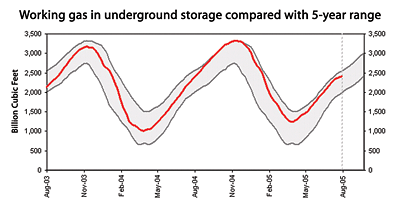By the time you read this, it will likely be too late to do much except hope for a warm winter.

Keeping Eye On Gas Storage
Those wishing to monitor progress in storing gas storage for the winter may do so by checking DOE's weekly report athttp://tonto.eia.doe.gov/oog/info/ngs/ngs.html. The farther the red line drifts below the upper gray line (Figure 1), the more bullish gas traders become, pushing up pricing to see just what the market (that's you) will bear. As long as the red line stays in the gray area, however, winter gas supplies should be sufficient. DOE's Energy Information Administration (EIA) issues this report every Thursday by about 11 a.m. EST.
The important number to watch is the "Implied Net Change." That number indicates how much gas has been added to the storage surplus. When lower than expected by the market, that's a signal that gas prices will either rise or stay high. The number remains positive until winter heating begins to draw down the surplus, and then becomes negative when more gas is pulled out than put in. For perspective, the weekly report compares results to the same week in prior years.
Coal Isn't Helping
The high use of natural gas by power plants has been exacerbated by recent problems delivering coal to Midwest power plants from fields in the Powder River Basin (coal fields straddling the Montana-Wyoming border), forcing them to use more natural gas, regardless of the weather. Utilities having both coal and gas-fired plants are using the latter to preserve their own on-site stores of coal to ensure they are available during the winter.Energy Trading Heats Up
Before the 2005 summer was over, forward pricing for both natural gas and electricity in several markets - already pushed high by ~$60 a barrel oil (the main alternative to gas for many industrial facilities and some power plants) - hit new records for the 2005/6 New England winter. In the PJM power market (i.e., mid-Atlantic states other than New York), wholesale power for the coming winter had also reached a new high by mid-August.
Just as last winter saw monthly wholesale gas trading at $.80 to $1/therm (exclusive of pipeline and delivery charges that add another $.10 to $.30, depending on region and utility service class), pricing at the New York Mercantile Exchange (NYMEX) for January-February 2006 were already pushing $1/therm by early August 2005. Kyle Cooper, a trader for Citigroup Global Markets, felt that those having gas to sell will likely hold onto it to get the best price. "No one is going to sell [their gas] until the winter," Cooper said to Platt's Megawatt Daily. "They're going to wait and see what they can get for it." That could means slim pickins for retail gas deals until next spring.
Gas And Electric Markets Tightly Intertwined
The convergence of natural gas and electricity markets has become tighter as more gas-fired power plants have come on-line to supplant older coal and oil-fired plants. Gas units represent nearly 90% of all new megawatts, and are being seen in nearly all major power markets. As the highest-cost source of power, gas-fired power plants are setting the price for all electricity sold in those wholesale markets.As more utilities buy power from that market (instead of building more regulated power plants), expect to see higher "fuel adjustment" charges on electric bills. In about half the states, utilities can pass such costs directly onto customers without a rate hearing. Utilities in other areas have been requesting rate hikes to make up for last year's high gas pricing - and will likely seek to do so again if this winter is also expensive.
The upside of all that new gas-fired generation is that the lights will stay on, making it easier to read and pay that higher electric bill. ES



